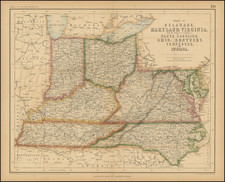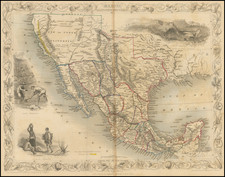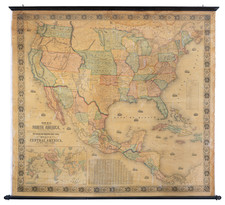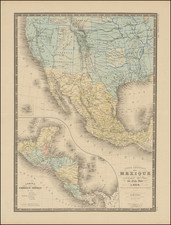Scarce early map of the Plains, Midwest and Rocky Mountains, drawn by E.F. Beadle and published by Miller, Orton & Mulligan.
Beadle's map extends from Ohio to the Rocky Mountains, north of the Ohio River and Indian Territory. It shows Nebraska Territory (created in 1854), west of Minnesota and north of Kansas. Kansas extends to the Rocky Mountains and includes the regions allocated to the Arapahos & Cheyennes, on the eve of the 1859 Colorado Gold Rush, with St. Vrains Fort, Ft. Laramie and Pueblo the only locations on the Eastern Slope.
The map tracks the course of the Missouri River and its tributaries, with a note showing Manuels Fort, a reference to one of the earliest known structures built on the upper Missouri. At some point in 1806-07, the fur trader Manuel Lisa established Fort Raymond at the mouth of the Bighorn River, where it entered the Yellowstone River. This was the first permanent structure of its kind on the Upper Missouri. It was at first just "two rooms and a loft". Lisa named it after his son, but traders also called it Manuel's Fort or Fort Manuel. Lisa built it for the company which he and William Clark owned (the St. Louis Missouri Fur Company). At the time of its establishment, Fort Raymond (Manuel) was the first permanent structure of its kind on the Upper Missouri. Lisa established the only trading post in the Great Plains region. This made the Fort instrumental in American relations with local tribes, as well as the early settlement of the Nebraska Territory.
In 1809 Lisa was one of the founders of the St. Louis Missouri Fur Company, later known as the Missouri Fur Company, which included members of the Chouteau family, founders of St. Louis. On his fur expedition in 1809 with 300 men, Lisa and his company built another fort further east, near the Gros Ventres village located between the mouth of the Little Missouri and that of the Big Knife rivers in what is now North Dakota. This was named Fort Lisa, or, as in the excerpt below, Fort Manuel Lisa Trading Post. He abandoned Fort Raymond/Manuel and shifted operations to the new post. The famous Astor Expedition would have stopped at Fort Lisa in 1811.
Henry Brackenridge, a fur dealer at Fort Manuel Lisa Trading Post on the Missouri River, wrote in his journal in 1811 that Sacagawea, the notable Native American guide for the Lewis and Clark Expedition, was living at Fort Lisa with her husband Charbonneau. He wrote that Sacagawea "...had become sickly and longed to revisit her native country." The following year, John Luttig, a clerk at Fort Manuel Lisa, recorded in his journal on December 20, 1812, that "...the wife of Charbonneau, a Snake Squaw, died of putrid fever." Fort Lisa was abandoned soon after this period.
The Indian Territory is indicated for the Cherokees. Original outline color with red showing railroad detail extending west to Iowa City.









![Map of Oregon Territory. By Samuel Parker. 1838. [with:] Journal of an Exploring Tour Beyond the Rocky Mountains, under the direction of the A. B. C. F. M. 1840.](https://storage.googleapis.com/raremaps/img/small/97939.jpg)


![The Mines of Colorado [with:] Map of Colorado Territory to accompany Hollisters](https://storage.googleapis.com/raremaps/img/small/100860.jpg)

